Dogs and horses go together like bread and butter; if you love horses, there is a good chance you are also a dog lover.
However, choosing the wrong dog to take on your horsey adventures can leave you wild-eyed and frazzled!
It can be challenging knowing which dog breeds get along with horses; in this article, we explore what makes a good horse-dog and what breeds have a reputation for getting along with horses.
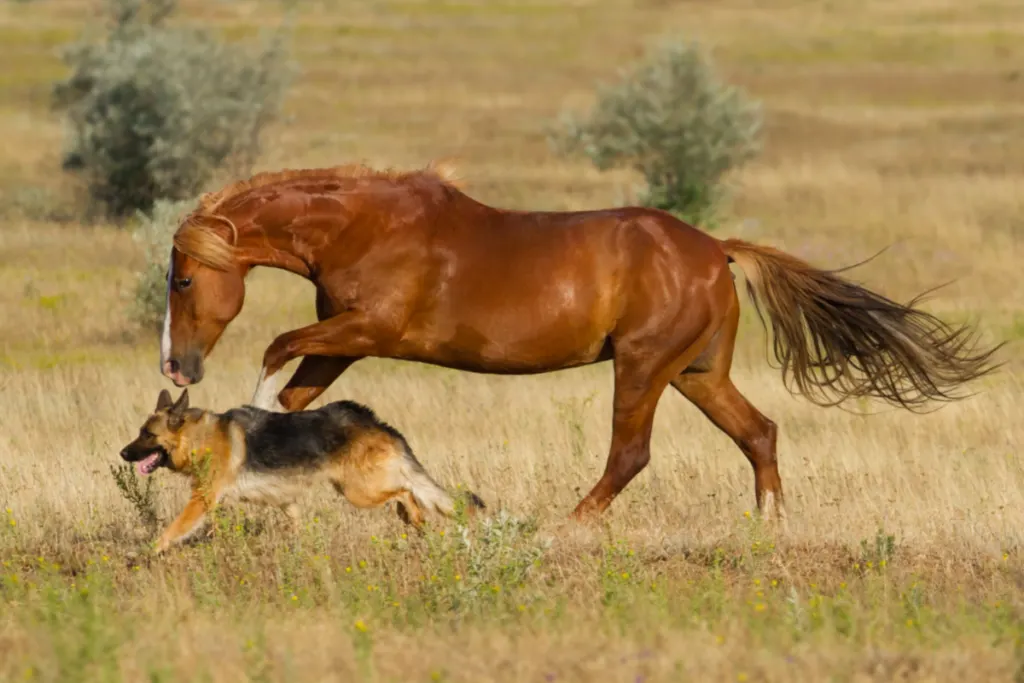
When choosing a horse-friendly dog, you need to consider the breed’s temperament, size, and coat. The 8 best dog breeds that get along with horses:
- Labrador Retriever
- Great Pyrenees
- Great Dane
- Rhodesian Ridgeback
- German Shepherd
- Border Collie
- Jack Russell Terrier
- Springer Spaniel
Most horse people enjoy bringing their dogs to the stable yard. However, an impolite or unfriendly dog can wreak havoc in an orderly yard, seriously endangering itself, the horses, and humans.
Choosing a horse-friendly dog breed to bring to the stable yard means teaching your dog to be polite and safe around horses will be a breeze; everyone will welcome you and your dog instead of running for the hills when they see your dog in tow!
To understand why these dog breeds are so popular with horse owners, you first need to understand what variables are considered when choosing a dog for a horse-centric household.
Click Here to Jump to a Section
How To Choose A Horse-Friendly Dog?
When people ask me to recommend the ultimate horse-friendly dog, my answer invariably frustrates them!
No dog breed fits seamlessly into every horse lover’s life.
Although numerous dog breeds get along well with horses, only one or two will be perfect for YOU and YOUR horse-centric lifestyle.
When considering which dog breed will mesh well with you and your horse, it is essential to consider:
- The breed’s temperament and common behavioral problems
- The dog’s adult size
- What horsey activities you would like your dog to join
- The breed’s coat
Many people choose their dog based on how cute or loveable the puppy is rather than a critical analysis of what you can expect from the adult dog.
However, it is far wiser to let your brain, not your heart, lead when choosing a dog to fit into your horse-based lifestyle.
Once you have made your carefully thought-out decision and brought your adorable new puppy home, you can let your heart take the reins as you fall in love with your new family member!
What Dog Temperament Gets Along With Horses The Best?
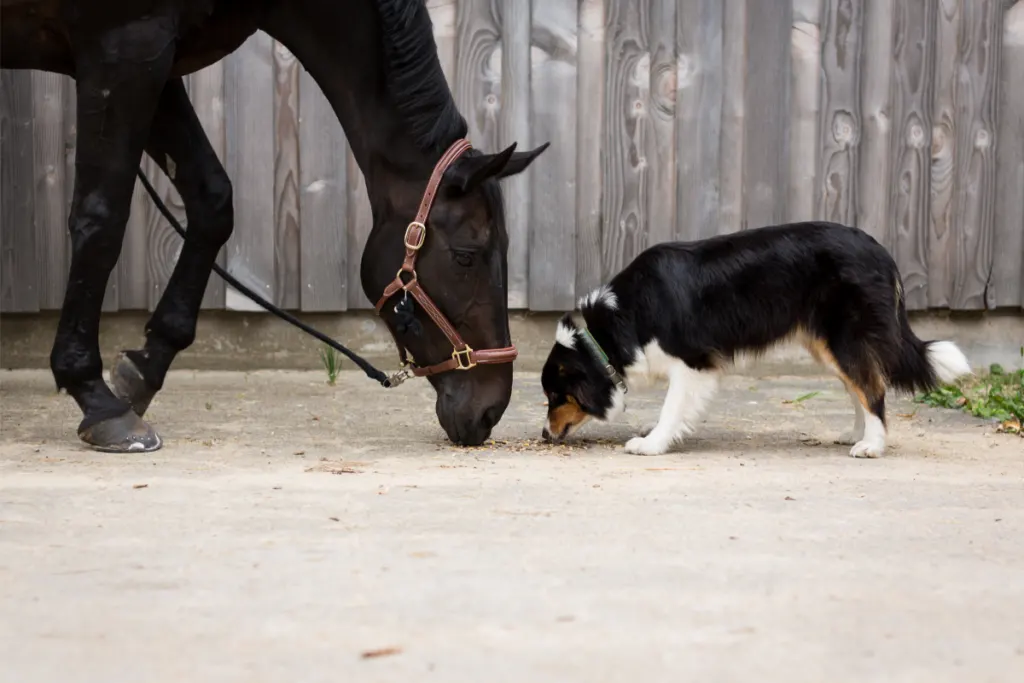
Most behaviorists agree that the dog’s temperament is the most critical factor for predicting how well they get along with horses.
The other factors, such as energy levels, coat types, and size, can all be negotiated depending on the dog and horse involved.
The ideal horse-friendly dog should be:
- Steady and not over-reactive
- Low prey/hunt drive
- Friendly to humans and other animals
- Highly trainable
A “steady” temperament allows a dog to encounter new and exciting situations without becoming anxious or overstimulated.
An anxious dog may attempt to bolt when faced with “the nightmare creatures” (a.k.a horses).
A dog with a calm, confident attitude towards life will be able to better tolerate the many scary or unusual situations they encounter in a busy stable yard.
Dogs love to chase!
They will happily chase each other, rabbits, and even their owners during their games. However, as prey animals, horses do not appreciate being chased.
Some dog breeds have a high chase-hunt drive and pose a significant danger to horse owners if the dogs cause the horse to bolt in fright.
Stable dogs should be friendly and sociable with strangers and other animals. Busy stableyards usually have other dogs, cats, and various four-legged animals.
If your dog gets on with horses but is a terror with other animals and people, their invitation to the stable yard will be rescinded.
Most dogs who visit the stable yard with their owners are allowed to run around off-leash, necessitating a high degree of off-leash obedience.
Dogs who are difficult or resistant to training may be old and grey before achieving the needed level of off-leash obedience!
What Size Dog Is Best For Horses?
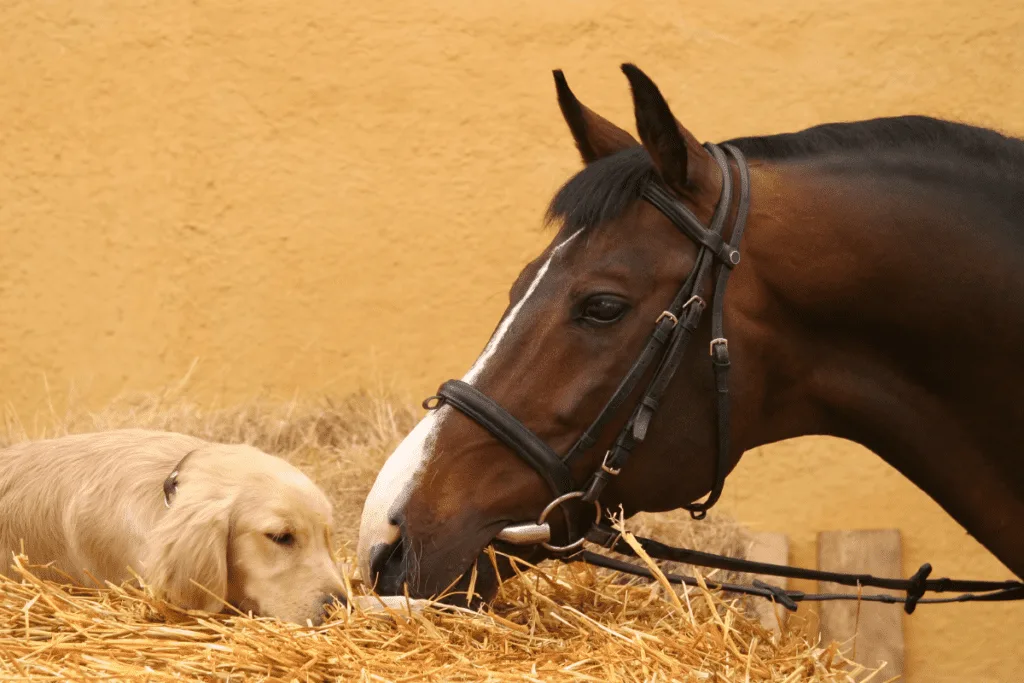
I’m going to state the obvious: HORSES ARE LARGE CREATURES!
Even the smallest of horses weighs upwards of 200 lbs (90kgs), with most riding horses weighing more than 1000 lbs (450kg).
Horses can cause serious injury to dogs if they accidentally stand on them or kick out in fright at a passing dog.
The horse does not intend to hurt the dog, but the lack of intention doesn’t negate the extent of the damage.
Medium, large and giant breed dogs tend to withstand accidental injuries better than small or toy breed dogs. The fragility of toy breed dogs makes them unsuitable for the rigors of stable life.
In addition to the dog’s size, it is essential to consider the dog’s build and conformation. Slow-moving brachiocephalic breeds like the English Bulldog, Pug, and Boston Terrier are an accident waiting to happen.
These sedentary breeds are not known for their stamina and speed. The dogs are often too slow to move out of the horse’s way, increasing the dogs’ chances of being accidentally run over.
Does A Horse-Friendly Dog’s Coat Matter?
The next factor to account for is your dog’s coat type. Regardless of the area, you live in, dogs belonging to horse owners:
- Spend a lot of time outdoors while their owners are busy in the stable yard.
- Often get tangled in weeds, thorns, and vegetation, especially when accompanying their owners on hacks across the countryside.
- Need to be easy to groom, as their owners rarely have time to devote hours to coat maintenance.
The outdoor nature of horse-based activities means that your dog should be able to cope with the local temperatures.
People living in scorching climates will do better with dogs that have short or medium coats.
Whereas horse owners living in cold areas of the country may want to look at dogs with thick, heavy coats – unless you’re a fair-weather rider, in which case, medium-haired dogs may also be suitable.
What Activities Do You Want Your Barn Dog To Join In?
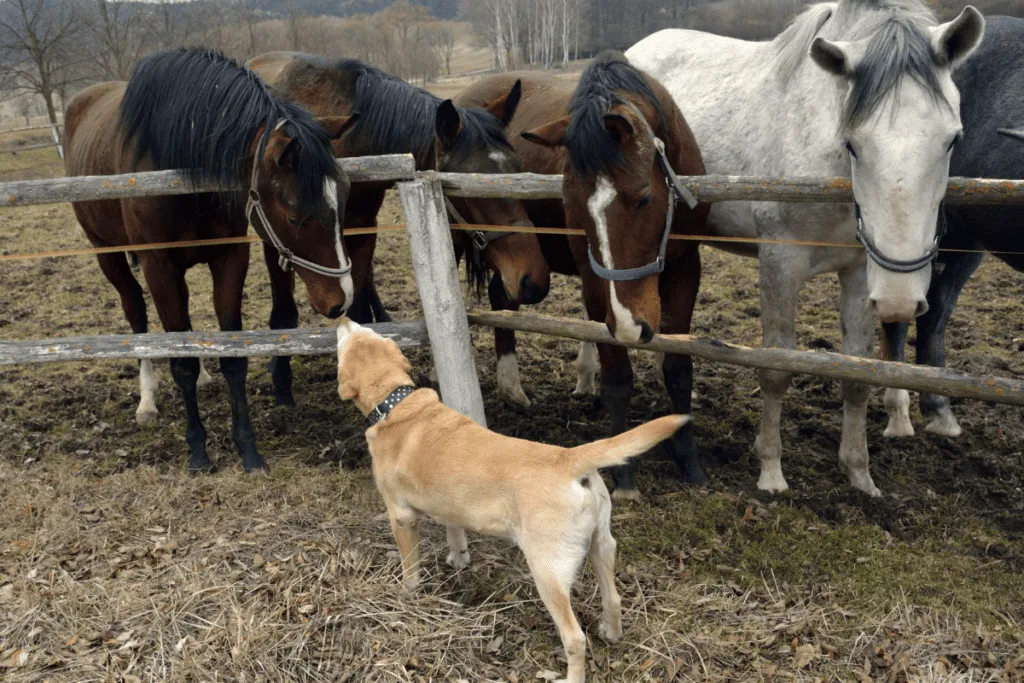
When choosing your horse-compatible dog, it is necessary to consider what activities and roles you would like your dog to perform. Dogs that go to the barn with you can be used for:
- Protection of livestock
- Protection of the stable yard
- Personal protection
- A friendly arena-side dog who is restricted to the stable yard
- An outride/hacking companion
- A canine support crew that goes with you to away-shows
It is essential to remember that a dog can fulfill multiple roles, but the roles he is expected to fulfill dictate what parameters are used to judge the “ideal” dog.
For example:
A dog who happily accompanies you to away-shows and is known as the friend-to-everyone will probably look at you like you’ve lost your marbles if you ever ask them to bite someone in your defense!
Or a dog who happily treks over miles of countryside with you and your horse may get an inappropriate case of the zoomies when you’re schooling a young horse – a scenario that makes me feel jittery just writing about it!
Knowing what you want your stable yard dog to do allows you to determine which breed has the ideal temperament, athleticism, size, and energy levels to fit in seamlessly with your horse adventures.
Now that we have covered what factors need to be considered when choosing a horse-friendly dog, we can see how our recommended breeds compare.
1. Labrador Retrievers
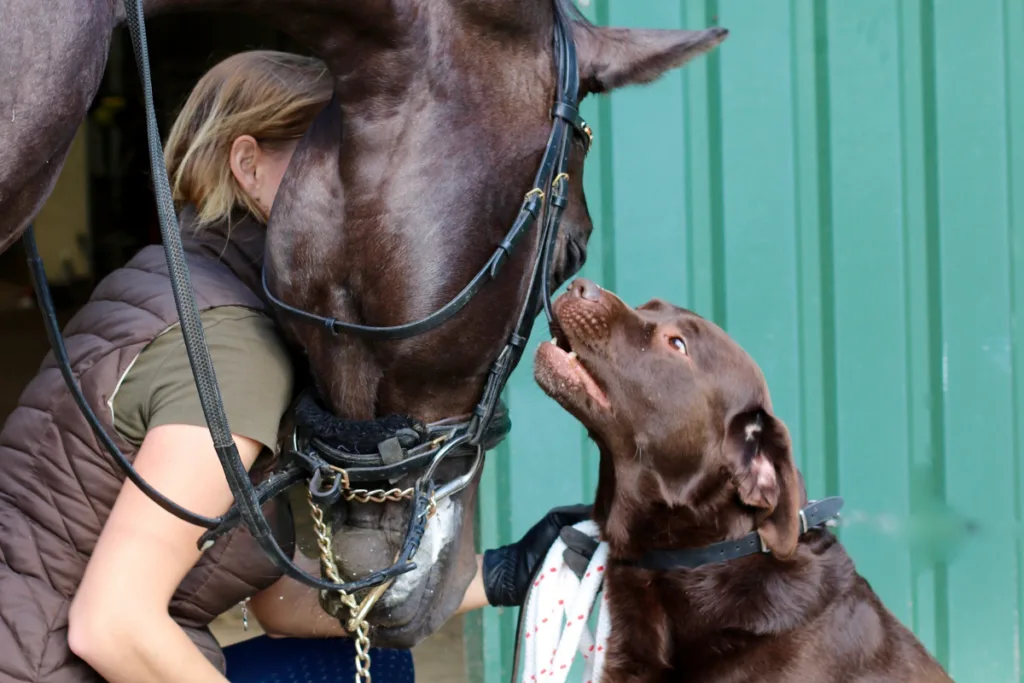
Temperament: Labradors are undoubtedly one of the most popular choices for horse owners. The American Kennel Club (AKC) describes the Labrador as a kindly, outgoing, tractable dog.
Labradors are known to have low aggression levels, high trainability, and a strong desire to please their humans.
Labradors are ideal for first-time or anxious owners as they are easy to work with and tend to view the world and its neighbor as their friends.
Size: Labradors are large breed dogs ranging between 21″ to 24.5″ (53cm to 62cm) at the top of their shoulder and weighing between 55lbs to 80lbs (25kgs to 36kgs).
This friendly breed is known for its stocky build and overall hardiness – this is no wilting flower that will break because a horse bumps them.
Coat: The Labrador’s coat is one of their selling points to horse owners; it is a short, straight, very dense coat that is all but waterproof.
Labradors have double coats with coarse guard hairs and a soft undercoat that allows them to tolerate both warm and cold temperatures.
The coarse guard hairs and short hair length rarely allow brambles and thorns to become entangled in a Labrador’s coat – Labrador owners don’t have to spend hours grooming their Labrador after every hack!
Activities: Labradors are ideal yard dogs who provide friendly companionship both within the yard and at away shows; however, few Labradors function effectively in protective roles.
Labradors, especially dogs from working lines, are great companions on short to mid-length hacks.
However, they are not known for exceptional speed or endurance and should be left at home if the hack is fast or overly long.
Potential equestrian-related pitfalls: Labradors are indiscriminate eaters and will often eat all manner of things they shouldn’t.
Many Labradors have gotten themselves into trouble because they got into the horse’s feed or tricked someone into giving them unhealthy snacks.
2. Great Pyrenees
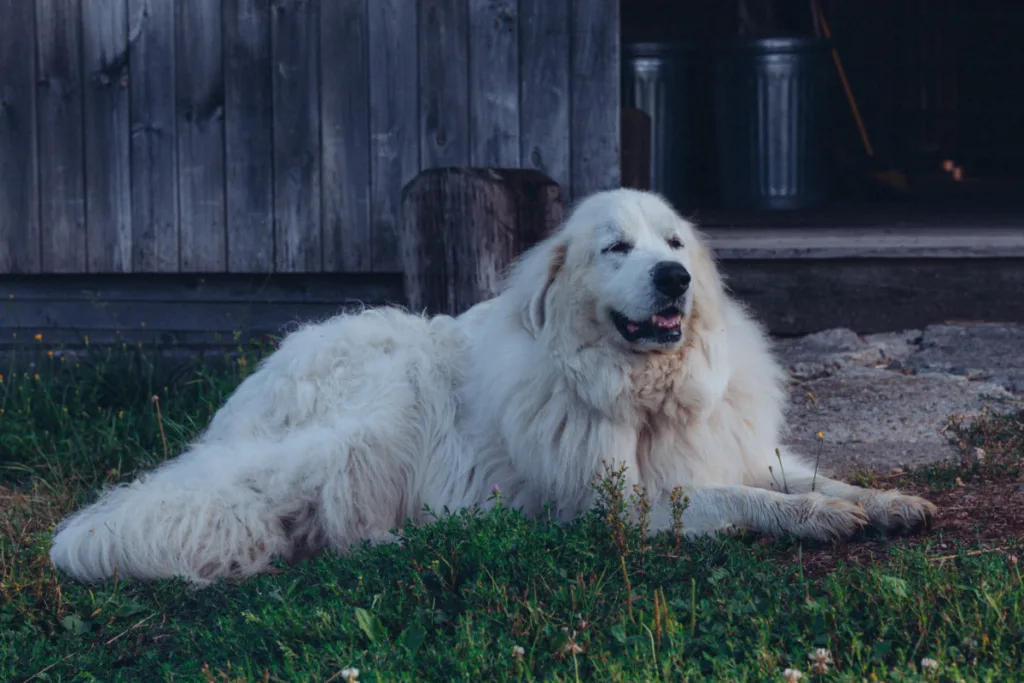
Temperament: The Pyrenean Mountain Dog, also known as the Great Pyrenees, is rarely seen in busy, commercial stable yards. However, this dog has a lot to offer the right horse owner.
These dogs are confident, even-tempered, gentle, and affectionate towards their family and the animals under their care.
They are often aloof and even suspicious when interacting with unfamiliar people, which has earned them a reputation for being unfriendly.
As a strong-willed, independent-minded dog, the Great Pyrenees can be challenging to train, although most dogs display an innate dignity and politeness that makes them a pleasure to be around.
Size: The Great Pyrenees is a giant breed dog standing at 25″ to 32″ (63cm to 81cm) and weighing between 85lbs and 130 lbs (38kgs to 59kgs).
These are solidly built, powerful dogs designed to defend their family and home with lethal force if necessary – for these dogs dealing with horses is a walk in the park!
Coat: This dog breed was developed to live outside all year round in the freezing conditions of the Pyrenees mountains, where the average winter temperature is a chilly 28 °F (-2 °C).
The Great Pyrenees ‘ coat reflects their ability to survive in these freezing conditions.
The dogs have a long, thick, weather-resistant double coat. The outer coat consists of straight, coarse guard hairs, while the undercoat comprises soft, dense, woolly hairs.
The Great Pyrenees’ coat can be challenging to maintain and is not ideally suited to warm climates. However, there is little need to fret about these dogs when visiting the stable yard on cold winter mornings.
Activities: Originally bred as a livestock guardian, the Great Pyrenees is a favorite with Miniature Horse and Shetland breeders.
These dogs are attentive and will fearlessly defend their equine charges when faced with wolves, bears, or other predators intent on getting an easy meal.
Potential equestrian-related pitfalls: As mentioned previously, this breed is an independent thinker, and obedience training is often an insurmountable task.
When choosing the Great Pyrenees to be your horse-friendly dog, it is essential to remember that this dog is still widely used as a working dog and may not act as an ordinary pet.
3. Great Danes
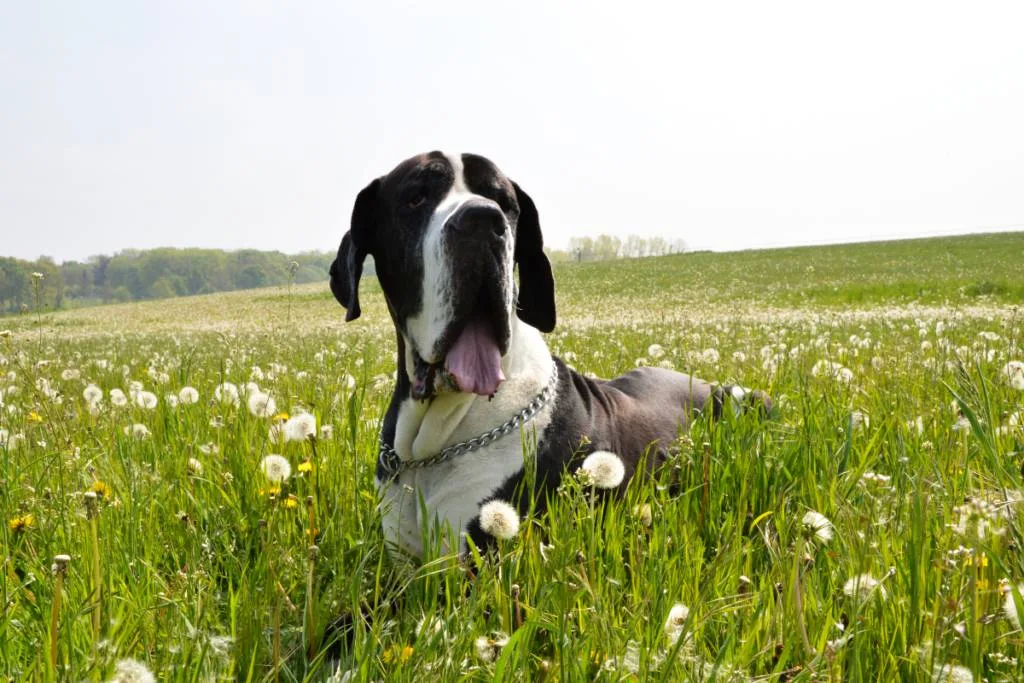
Temperament: Steady, dependable, and kind – many people may be tempted to pass over the unassuming Great Dane in favor of more dynamic dog breeds, but it’s their loss.
Great Danes are known for their quiet dignity and unflappable nature, making them favorites with horse owners who can’t afford to split their attention between a demanding dog and a spooky horse.
Size: As an undisputed giant breed dog, Great Danes stand 28” to 32” (71cm to 81cm) at the shoulder and weigh between 100lbs to 200lbs (45kgs to 90kgs).
Although Great Danes become strong, powerful adults well suited to the rigors of stable yard life, as puppies, they remain relatively vulnerable.
Like all dogs, if Great Danes are injured during their early years, it can have long-term consequences that will continue to affect them throughout their life.
Coat: Great Danes’ have a short, glossy coat that is a breeze to keep healthy. Although Great Danes will benefit from weekly brushing, this is not necessary – it just means that there will be a few more dog hairs adorning the house furniture.
Due to their short coat, Great Danes do better in warmer climates.
Activities: Great Danes are a relatively sedentary breed and are unlikely to enjoy accompanying you on outrides.
However, Great Danes make fantastic stable yard dogs.
This breed is known to be friendly and gets on well with other people, children, and animals, making them the preferred dog for busy children-centric stable yards.
Potential equestrian-related pitfalls: Like the Labrador, Great Danes are a solid choice for horse owners and have relatively few drawbacks.
However, some Great Dane lines exhibit undesirable levels of anxiety and aggression. Thus it is essential to buy puppies from well-respected, responsible breeders.
4. Rhodesian Ridgebacks
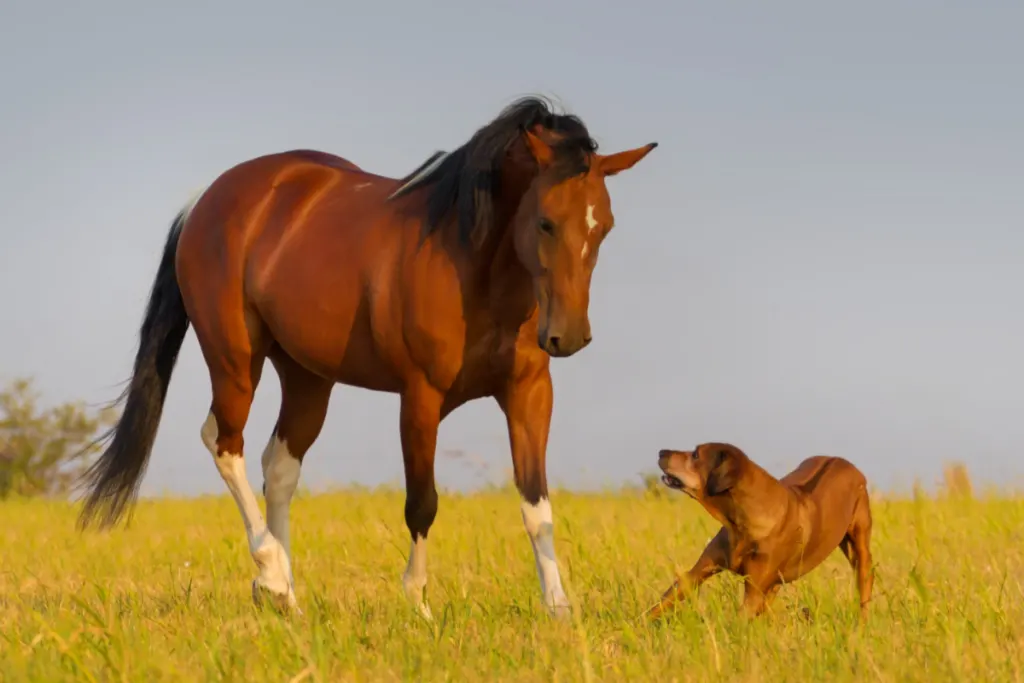
Temperament: Although relatively uncommon in the USA, Rhodesian Ridgebacks are the go-to stable dog for South African horse owners.
Although the AKC describes Rhodesian Ridgebacks as dignified, reserved dogs, this has not been my experience with all Rhodesian Ridgebacks.
Most juvenile Rhodesian Ridgebacks are high-energy clowns who love playing wildly with anyone who’s willing. The dignity and reserve tend to develop as the dog matures.
They are relatively easy dogs to train, although not as soft and gentle as dogs like the Labrador Retriever.
Size: Classified as a large breed dog standing at 24″ to 27″ (60cm to 69cm) and weighing 70lbs to 85lbs (31kgs to 39kgs), the Rhodesian Ridgeback is a powerfully built athlete.
Coat: The Rhodesian Ridgeback coat is the ultimate low-maintenance coat and does not require daily brushing.
Although the coat is highly unlikely to become tangled in grass seeds, the short coat offers no protection when walking through thorny underbrush.
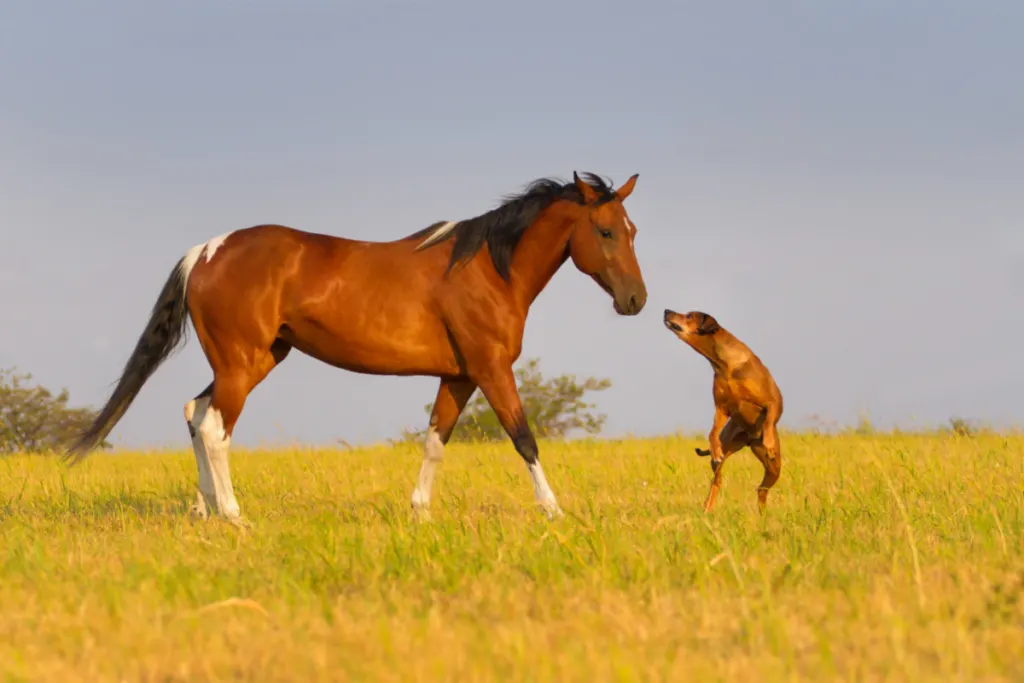
These dogs do best in warm climates and will need additional protection during the cold winter months.
Activities: Rhodesian Ridgebacks are the ideal dog for avid trail riders. These dogs are built for endurance and effortlessly cover the distance with their ground-eating stride.
A well-socialized Rhodesian Ridgeback is a comfortable companion; they tend to be level-headed, friendly, and polite when approaching new people or unfamiliar situations.
Some Rhodesian Ridgebacks have found their calling in protection work and can offer horse owners another layer of security.
Potential equestrian-related pitfalls: Rhodesian Ridgebacks were originally bred as high-energy hunters, and their excessive energy can often lead a bored Rhodesian Ridgeback into trouble!
Rhodesian Ridgebacks will chase and even kill small animals, including cats, rabbits, goats, and sheep unless they are taught not to.
This is not to say that every Rhodesian Ridgeback will exhibit this behavior; consistent training throughout their life is the key to creating a solid citizen who is a pleasure to be around.
5. German Shepherds
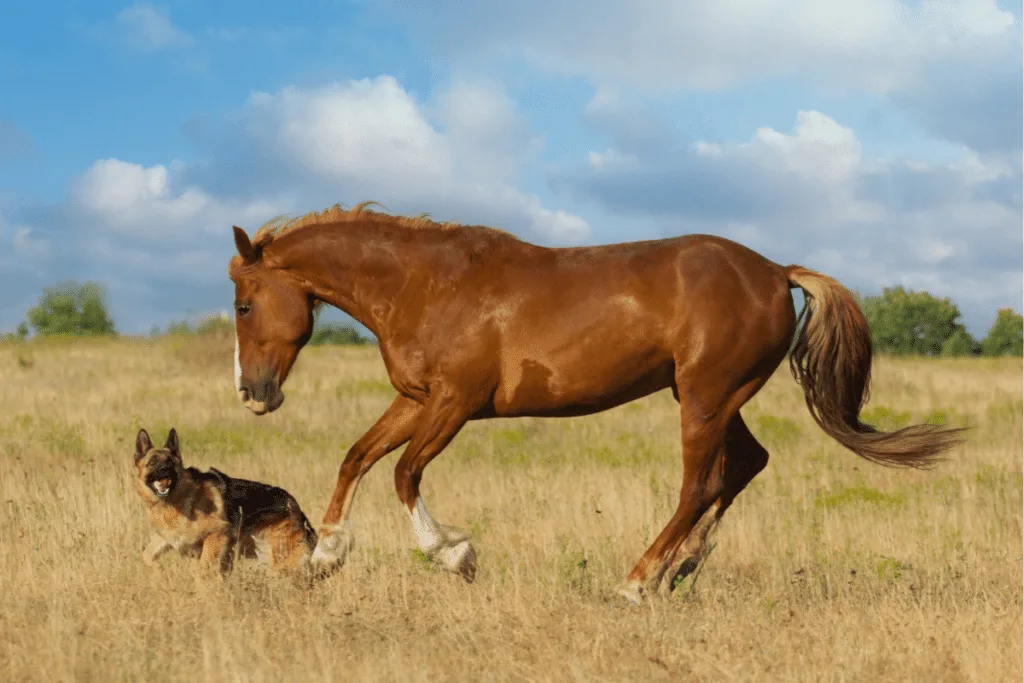
Temperament: German Shepherds remain popular with yard owners despite not being the easiest dog to own.
The best way to describe German Shepherds is to call them “intense, possibly manic, overachievers.”
German Shepherds are loyal defenders of “their” people, and while they should not be aggressive to strangers, neither should they be overly friendly.
When handled by a confident, experienced handler, German Shepherds are incredible dogs but can be “too much dog” for inexperienced or anxious people.
Size: The AKC classifies the German Shepherd as a large breed dog standing at 22” to 26” (55cm to 66cm) and weighing 50lbs to 90lbs (22kgs to 40kgs).
While this breed is generally quite robust, some show lines are plagued by conformational issues that compromise the German Shepherd’s soundness.
Dogs from working lines tend to have the more functional conformation and perform better over long distances than show dogs.
Coat: German Shepherds have a medium-length coat that should lie flat and straight along their body.
While German Shepherds benefit from a quickly weekly brush, their coat is relatively low maintenance and resistant to tangles.
German Shepherds tolerate both warm and cold climates.
Activities: Many horse owners spend their evenings in remote stable yards.
A trained German Shepherd may be the perfect dog for horse owners who want a little more protection when working around the yard.
German Shepherds are a popular choice for personal protection dogs. These fiercely loyal dogs will happily accompany you around the yard and on hacks, providing an additional layer of security.
Potential equestrian-related pitfalls: As a herding breed, German Shepherds have a well-developed chase or hunt drive.
Owners will need to be diligent when working with their German Shepherd to prevent any chasing behavior from appearing – in this case, prevention is better than cure!
Related: Are German Shepherds Good Livestock Guardians? All You Need to Know
It is not only horses that German Shepherds may be tempted to chase.
Many German Shepherds will happily give chase to anything that moves, including barn cats, cars, and any livestock that you may pass on your hacks.
Lastly, German Shepherds are frequently listed as dangerous dogs. There may be legal restrictions that prevent your German Shepherd from accompanying you on hacks or to a public stable yard.
6. Border Collies
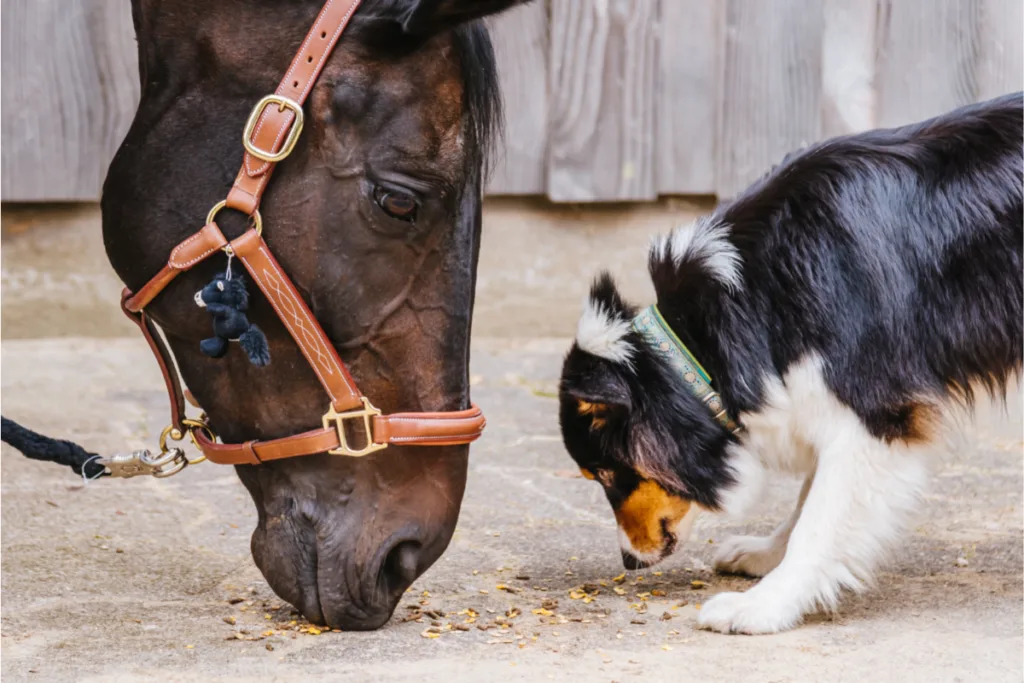
Temperament: Border Collies are the quintessential farm dog; it is difficult to picture the traditional bucolic English farmyard without a resident
Border Collie. Border Collies are known for their MENSA-level intelligence; they are an energetic, alert breed that thrives on a challenge.
Size: The Border Collie is not a large dog and is classified as a medium-sized dog breed standing at 18” to 22” (45cm to 55cm) and weighing 39lbs to 66lbs (18kgs to 30kgs).
Although the Border Collie is relatively fine-boned, they are agile dogs who nimbly avoid horse hooves.
Coat: Border Collies come in two coat types Rough (Long) and Smooth (Short).
The rough-coated dogs do well in cooler climates, while smooth-coated border collies happily live in warmer parts of the country.
The rough-coated Border Collie’s coat is more prone to getting tangled and requires more grooming.
However, a Border Collie’s coat is relatively low maintenance compared to other long-haired dogs.
Activities: Border Collies are tireless companions when out hacking; their intensity and focus are given a useful outlet when they are forced to navigate the terrain on extreme trails.
Border Collies are often used as the canine partner in tricks involving horses and dogs – even if you are not a professional showman, training your dog with your horse can be a fun bonding activity.
Potential equestrian-related pitfalls: While obedience training is typically a breeze with this breed, keeping up with them is not.
A bored Border Collie will often entertain itself by herding the stable yard’s loose horses, geese, cats, and unsupervised children – an act that not everyone appreciates.
If you’re a dressage rider who expects your dog to sit quietly on the arena side while you practice your test, the Border Collie is not your dog.
These dogs have abundant physical and mental energy and do best with an equally dynamic owner.
Generally, pet or show Border Collies are slightly lower energy than their working counterparts and are a better fit for most hobbyist horse owners.
A busy horse owner rarely has the time to devote to a working Border Collie.
7. Jack Russell Terriers
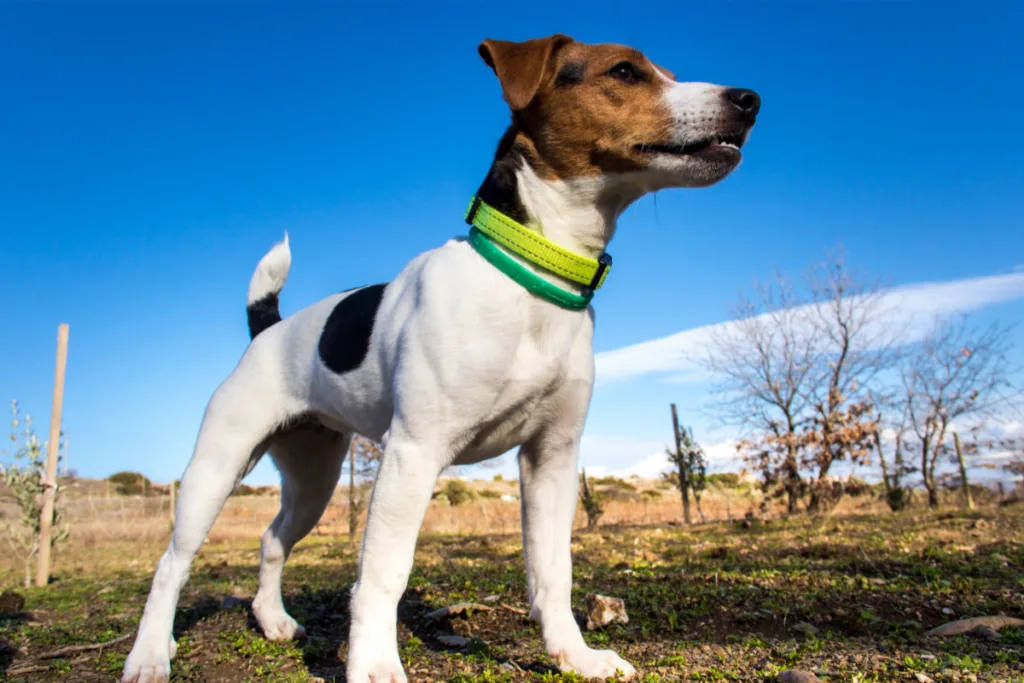
Temperament: Jack Russell Terriers are tiny forces of nature; they have a “never say die” attitude to life that has endeared them to thousands of horse owners.
Although Jack Russell Terriers are rarely models of good behavior, they remain firm favorites within the horse community.
Jack Russell Terriers can excel at obedience if their owner is willing to put in the time.
However, convincing Jack Russell Terriers NOT to fight every dog that challenges them while accompanying you on a hack takes time and persistence.
Size: Standing 10″ to 12″ (25cm to 30cm) at the shoulder and weighing 9lbs to 15lbs (4kgs to 6kgs), the Jack Russell Terrier is the only small dog breed to make this list.
Generally, small dogs and horses are a recipe for disaster, but the indomitable little Jack Russell Terrier lives to defy the odds!
Despite their many hair-raising adventures in the hayloft catching rats, these dogs are surprisingly adept at avoiding injury.
Coat: Jack Russell Terriers come in three coat variations: smooth (short and satiny), broken (slightly longer and coarser), and rough (medium-length, wiry coat).
The rough-coated Jack Russell Terriers may have better cold tolerance than the smooth-coated variety, but all three coat types tolerate warm weather.
In addition to this, the wiry-coated Jack Russell Terriers are more protected when pushing their way through dense underbrush but may be more prone to developing tangles that need to be brushed out.
Activities: Jack Russell Terriers are popular with horse owners because of their versatility. T
hey are the perfect size to make transporting to away shows easy but have the energy and athleticism necessary to keep up with you on hacks.
This breed tends to get on well with children and unfamiliar people if socialized from a young age. Perhaps the greatest selling point for Jack Russell Terriers is their rat-catching abilities.
Most stable yards have a nerve-ending battle with vermin, which can easily be solved if a Jack Russell Terrier is installed as the resident yard dog.
Potential equestrian-related pitfalls: I have yet to visit a stable yard with a young, excitable Jack Russell Terrier who does not chase the horses and barn cats.
Unfortunately, the qualities that make this breed excellent rat catchers also make them enthusiastic horse and cat chasers.
Maturity and training usually resolve this behavioral issue.
Still, horse owners must understand that the first few years of owning a Jack Russell Terrier will be a big adjustment for both human and dog.
8. English Springer Spaniels
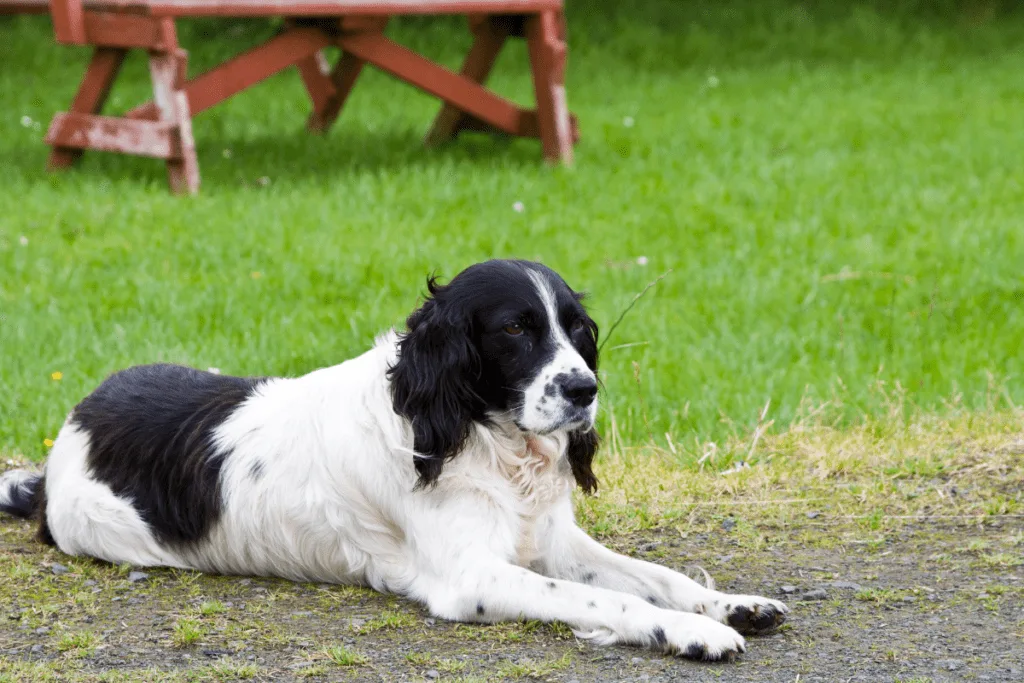
Temperament: English Springer Spaniels have cornered the market on charm. This breed is friendly, attentive, quick to learn, and eager to please.
A well-bred English Springer Spaniel is a pleasure to have around the stable yard.
They tend to approach strangers with a calm friendliness that can make them more appealing than an overly exuberant dog of another breed.
English Springer Spaniels have a low chase drive making them one of the easiest breeds to teach good manners around horses.
Size: English Springer Spaniels are elegantly built athletes standing at 19” to 20” (48cm to 51cm) at the shoulder and weighing between 40lbs and 50lbs (18kgs to 23kgs).
Coat: English Springer Spaniels have a gorgeous medium-length outer coat and soft, dense undercoat.
The AKC describes the Springer’s coats as waterproof, weatherproof, and thornproof, making this the ideal dog to take on extreme trails.
Dogs from show lines have significantly more hair than the working English Springer Spaniels.
While these show dogs are undeniably stunning, their coat makes them an impractical choice for a horse owner who dreams of completing multi-day trails with her horse and dog.
Although show dogs are not suitable hack companions, they do just fine as stable yard dogs. Both show and working line English Springer Spaniels tolerate hot and cold weather equally well.
Activities: Like the Jack Russell Terrier, the English Springer Spaniel is a versatile companion for horse owners.
This breed will happily accompany you on hacks but are equally content to settle in for a nap at the side of the arena while you school your horse.
Well-socialized English Springer Spaniels tend to be welcome guests at dog-friendly horse shows.
Their handsome good looks are sure to attract attention – speaking to other people before your class is an excellent way to control those show nerves, but so is petting your Springer!
Potential equestrian-related pitfalls: A well-bred, well-socialized English Springer Spaniel is generally a shoo-in with horse owners.
BUT and there is a fairly big but, many poorly bred English Springer Spaniel exhibit excessive aggression and anxiety that deviates significantly from the AKC’s description of an ideal English Springer Spaniels temperament.
Temperament issues are more common in show lines than in working lines.
When buying an English Springer Spaniel, only purchase a puppy from a registered breeder who has temperament tested their dogs and has used their dogs in a functional capacity beyond the confines of the show ring.
Final Thoughts
Let’s finish up with something to lift your spirits – dogs and horses playing together!
